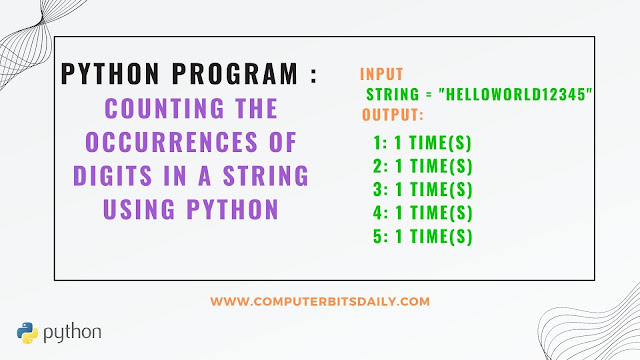In today's digital world, data analysis, and manipulation are crucial skills for any aspiring programmer. Python, being a versatile and powerful language, provides a multitude of functionalities to tackle such tasks efficiently. One common requirement is to count the occurrences of specific characters within a string. In this blog post, we will explore how to write a Python program that counts the occurrences of each digit in a given string. Whether you're a beginner or an experienced coder, this tutorial will guide you through the process step by step.
Table of Contents:
- Understanding the Problem
- Approach and Logic
- Implementation of the Python Program
- Testing the Program with Examples
Understanding the Problem:
Before diving into coding, it's essential to grasp the problem at hand. We are given a string containing various characters, including digits. Our goal is to create a program that counts the occurrences of each digit in the string. For instance, if the input is "12203AB3", the program should output the following counts: 0 (1 time), 1 (1 time), 2 (2 times), 3 (2 times).
Approach and Logic:
To solve this problem, we will follow a simple approach. We will iterate through each character in the string and check if it is a digit. If it is, we will update a dictionary to keep track of the digit counts. Finally, we will display the counts for each digit present in the string.
Implementation of the Python Program:
Let's dive into the implementation of the program. Below is the code snippet that counts the occurrences of each digit in a given string:
def count_digit_occurrences(string):
digit_counts = {}
for char in string:
if char.isdigit():
digit_counts[char] = digit_counts.get(char, 0) + 1
return digit_counts
# Example usage
string = "12203AB3"
result = count_digit_occurrences(string)
for digit, count in result.items():
print(f"{digit}: {count} time(s)")
| Practice Python MCQ with "Python MCQ Programs Interview " Android App.
Testing the Program with Examples:
Let's test our program with a few examples to validate its functionality:Example 1:
Input: "12203AB3"Output:0: 1 time(s)1: 1 time(s)2: 2 time(s)3: 2 time(s)
Input: "HelloWorld12345"Output:1: 1 time(s)2: 1 time(s)3: 1 time(s)4: 1 time(s)5: 1 time(s)
In this tutorial, we have explored how to write a Python program that counts the occurrences of each digit in a given string. By following a simple approach, we were able to achieve our goal efficiently. Python's versatility and built-in functions, such as isdigit() and dict.get(), made the implementation concise and straightforward. Remember to leverage these techniques for similar problems in your future coding endeavors.
Remember, practice makes perfect, so try implementing this program with your own string inputs and see the results for yourself! Happy coding!
| Practical List - Python [ 4330701 ] [ PRACTICAL EXERCISES ]
FAQ: Python Program to Count Occurrences of Digits in a String
Q1: What does the Python program do?
A1: The Python program counts the occurrences of each digit in a given string. It determines how many times each digit appears in the string.Q2: How does the program count the occurrences of digits?
A2: The program iterates through each character in the string and checks if it is a digit. If a character is a digit, it updates a dictionary to keep track of the digit counts.Q3: What is the format of the program's output?
A3: The program outputs the count of each digit present in the string. For example, if the input string is "12203AB3", the program will display the following counts:0: 1 time(s)
1: 1 time(s)
2: 2 times(s)
3: 2 times(s)




0 Comments